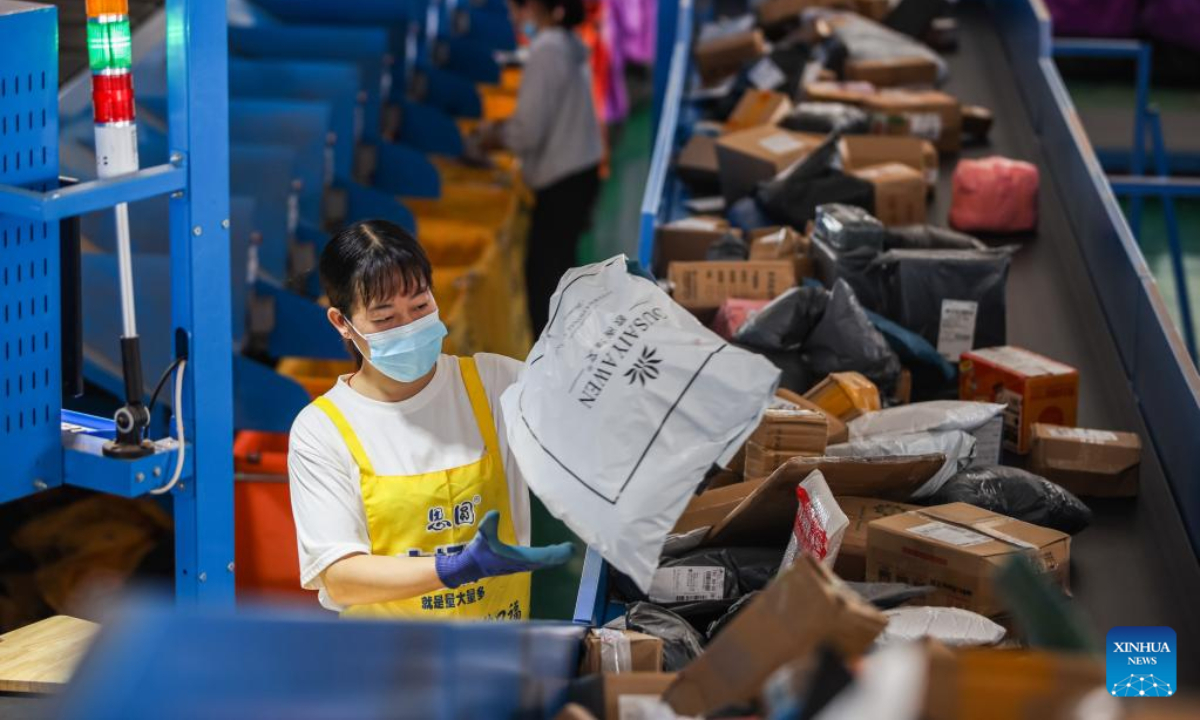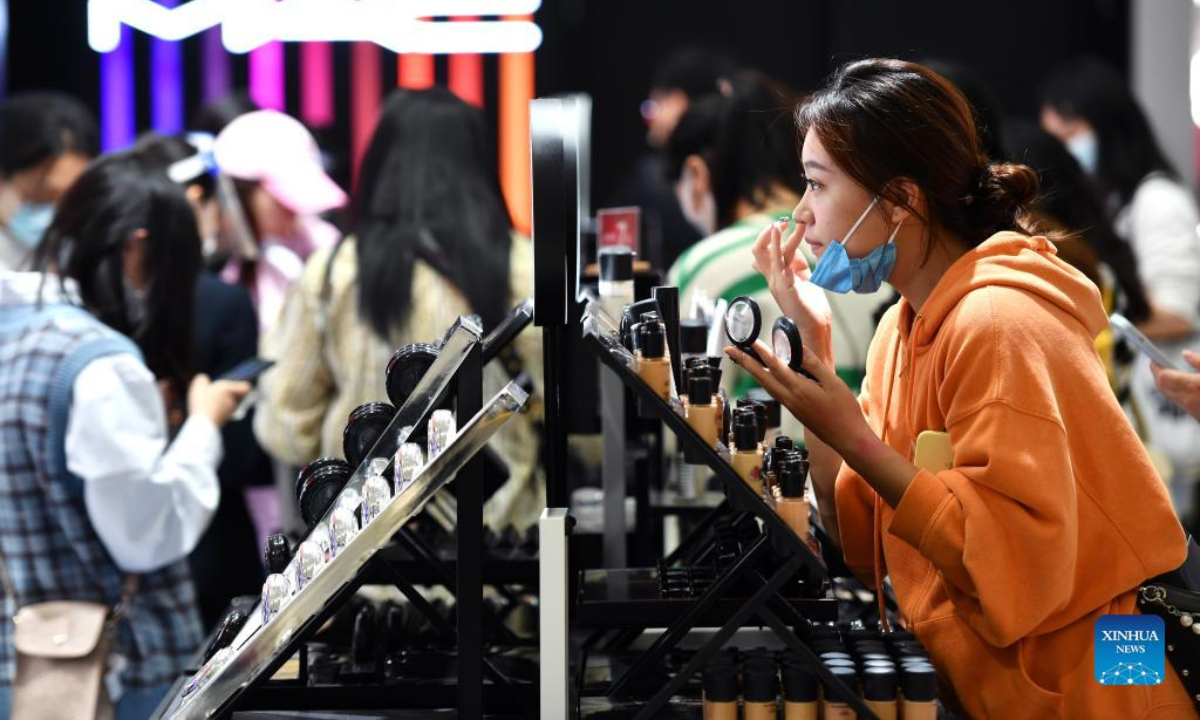China on December 7 further optimized its anti-COVID-19 measures, ushering in a new chapter in the response to the pandemic. While the lifting of restrictions boosted confidence in a rapid economic recovery, some foreign media outlets also spared no effort in smearing China’s anti-COVID measures and China’s economy. To debunk such cliché “China collapse” claims, the Global Times is publishing a three-part series to illustrate how Chinese ingenuity and diligence not only kept export, investment and consumption – three pillars of the Chinese economy – resilient over the past three years but also ensure long-term development despite challenges. This is the third article focusing on how China taps into the inherent resilience of its consumer market, the creativity of online marketing and its push to build a consumption-driven economy for a post-COVID-19 rebound to be on firm footing.
As metropolises such as Beijing and Guangzhou, South China’s Guangdong Province are emerging from the initial wave of coronavirus infections during the transition of the country’s COVID-19 response phases, the amiable hustle and bustle is gradually seen clawing its way back to reviving the virus-hit consumer market.
Adding to the pleasant boisterousness is a slew of pro-consumption moves by local governments to ready excited crowds for moments of joy as the New Year’s Day holiday and Spring Festival are approaching.
Among a rollout of local measures are the third installment of consumption vouchers being disbursed by the Guangzhou municipal government and the offering of 200 million yuan ($28.61 million) worth of consumption vouchers by the Nanshan district in Shenzhen, Guangdong, Chinese state broadcaster CCTV reported on Friday.
In the case of Zhoushan in East China’s Zhejiang Province, a promotional activity is being unfolded to foster local tourism, with the Putuo Mountain scenic area switching on the ticket-free mode, according to the report.
With rising signs of a fundamental revival in consumer sentiment after three years of dealing with the virus, industry insiders and economists alike are deepening their faith in the country’s spending power that may have somewhat hibernated amid the prolonged epidemic. A super strong signal from the central government to jumpstart the consumption bandwagon on wide-ranging fronts is considered to fast-track a consumption rebooting.
The inherent vigor, as such, is seen painting a picture of consumption resilience in the world’s second largest economy that suffices for a number of economists to be confident about next year’s consumption rebound, which some say could jump by 5-10 percent without unexpected occurrences.

A staff member distributes parcels at the workshop of a logistics company in Lanshan County of Yongzhou City, central China’s Hunan Province, Nov 10, 2022. Photo:Xinhua
Inherent resilience
During a press conference held by Alibaba’s Tmall on the afternoon of November 11, just a few hours before the e-commerce giant wrapped up this year’s Double 11, the country’s grandest online shopping festival, Ye Gen, founder of domestic paint protective film (PPF) company Moxiaoer, was asked whether his company’s products have quality and technological gap compared with some overseas brands that came out in front on certain PPF lists.
Ye answered almost immediately: “In terms of sales numbers, we have surely surpassed them, and in terms of quality, we have no difference with those imported brands.”
To some extent, Ye’s words reflected the confidence of a new generation of Chinese private manufacturers and entrepreneurs in the appeal of their products to domestic customers not only because of affordability, but also because of the accumulated advantages in their services and technology-backed product quality.
The blossoming of homegrown, high-quality goods despite the virus-inflicted fallout on consumption across the globe apparently adds to the country’s rising profile in the global consumer markets — evidenced by its sustained role as the linchpin of global consumer spending and its export of creative way of marketing online shopping.
In the past decade, the external environment was never as harsh as the past three years for China’s consumer market, as repeated waves of large-scale coronavirus cases have broken out in domestic cities that restricted people’ s shopping abilities and impulse, but the sector was never experiencing a slide like some overseas markets did.
In the first 11 months this year, China’s total retail sales of consumer goods dropped a slight 0.1 percent compared with last year, data from the National Bureau of Statistics showed.
Data released by Alibaba also showed that the gross merchandise volume (GMV) for 2022’s “Double 11” online festival was “the same as last year,” a figure that quite matches the overall consumption picture.
Experts said that the numbers are understandable or even impressive to some extent, when compared with a consumption plunge in certain overseas markets for reasons like soaring inflation and weaker demands.
The eurozone’s retail turnover fell by 1.8 percent in October, data published by Eurostat, the EU statistics agency, showed. It was the biggest drop since a 2.1 percent decline in December 2021, as European customers cut spending on everything from gas to fruits.
Chinese consumers faring better than their European counterparts is arguably attributed to the inherent resilience of China’s consumer market, experts and industry insiders said.
“China has three factors that could support it to have a better consumption rebound compared with Europe and the US. First and the primary reason, China’s inflation level is not high. Second, Chinese people have more deposits compared with overseas residents. Thirdly, Chinese citizens’ income growth is not bad this year, which means that consumption bottleneck is not because they don’t have money to spend, but because of coronavirus restrictions,” said Tian Yun, a veteran macro economist.
In the first half of this year, Chinese people’s per capita disposable income rose 4.7 percent on a yearly basis, official data showed.
Another highlight of China’s consumption sector in the past few years is that the economic and social transition has boosted the demands for several new areas where people are willing to spend their money on.
Alibaba have summarized four new pillars of those new growth sectors — pets, toys, outdoors and jewelry — which are replacing the traditional areas of consumption such as clothing and cosmetics.
According to data sent by Alibaba to the Global Times, a total of 358 brands under those four new categories saw their sales volume exceed 100 billion yuan in the past year, while 3,434 brands saw sales volume surpass 10 million yuan, a growth that is largely higher than the general consumption growth speed.
The rapid development of high-tech industries also boosted market demands for certain products that people did not need that much before.
Ye from Xiaoer, for example, disclosed that his company, though just four years old, had an average yearly growth of about 150 percent in the past two or three years.
He also said that the company’s turnover stood at about 32 million yuan during this year’s Double 11 festival, up 60 percent on a yearly basis. He attributed the growth mostly to the rapid development of China’s new-energy vehicle industry in recent years.
Domestic sportswear brand TOREAD told the Global Times that the company achieved “high-speed growth” in sales turnover in this year’s Double 11 online festival in product categories like shoes and outdoor jackets.
“Our product stock for this year’s Double 11 and Double 12 shopping sprees was more sufficient than last year, including products of different categories and prices.”
The company noted that with continuous fermentation of the camping boom, the scale of the domestic outdoors market is still not big, and in the past two years, a large number of subdivision tracks and brands have been created, which has great potential for rapid development.
According to Fan Zhicong, founder of Zhichong Technology Co that specializes in pet products, the rise of new business forms such as the pet economy is a microcosm of the change of the main consumption force and consumption concept in China. With the rise of the younger generations and the expansion of the elderly population, personalized consumption and aging consumption usher in huge opportunities.
“According to our research, the development of this new type of business is driven by the economic level, not by traditional industries. Therefore, the two do not conflict, but will jointly form and promote the diversified Chinese consumption market,” he told the Global Times.

A customer tries cosmetic products in a duty-free shop in Haikou, capital of south China’s Hainan Province, Jan 3, 2022. Photo:Xinhua
Riding consumption waves
Other than the new realms of consumer goods that have accounted for a bigger part of Chinese consumers’ bills, the huge popularity of livestreaming commerce has over the past few years been reliant on to bring China’s consumer sophistication to a new level. Such marked creativity alongside the country’s unwavering push to build itself into a consumption-oriented economy is reputed to have increasingly rendered China a bulwark against waning global consumer confidence.
While the COVID-19 has inevitably weighed on consumer spiritedness and logistics readiness, the prolonged epidemic seems to have unleashed the indigenous potential of rising against adversity. A typical example was Dong Yuhui, a former off-campus English tutor at New Oriental who capitalized on his bilingual erudition to turn himself into a livestreaming sales sensation.
Buoyed by the 29-year-old’s huge success, shares of Koolearn Technology Holding in Hong Kong trading, whose farm produce-centric e-commerce channel incubates livestreaming idols such as Dong, have staged a meteoric surge of more than 800 percent to date. Koolearn’s largest shareholder, New Oriental, has also seen its shares rally in both the US and Hong Kong markets throughout this year.
The shooting to fame fundamentally dovetails with a broader shift toward livestreaming commerce.
Data from Chinese consultancy iiMedia Research showed that the country’s live online users would have hit 660 million by 2022. The country’s live e-commerce market that amounted to 1.2 trillion yuan in 2021 was expected to reach 2.14 trillion yuan by 2025, the consultancy estimated.
In the case of TOREAD, livestreaming also makes an important part of its stellar sales results. The company revealed to the Global Times that it cooperated with live streamers including top ones and middle-level ones to maximize the effect of getting customers at key activity nodes over the shopping sprees.
Domestic livestreaming prowess also comes across as enlightening businesses from the rest of the world to relish the marketing creativity.
Earlier this year, a Belt and Road Initiative (BRI)-themed livestreaming studio was set up at Shougang Park, one of the twin venues for the 2022 China International Fair for Trade in Services (CIFTIS) in Beijing.
“This is the best chance for us to promote Sri Lankan products,” Chiranjaya Udumullage, president of the China Sri Lanka Association for Trade and Economic Cooperation, told the Global Times.
Udumullage, who can speak Putonghua, joined another Chinese livestreamer earlier this year to interact with the audience in the session, during which Sri Lanka tea culture was a main selling point.
As livestreamed commerce goes viral across the globe, such events are expected to be increasingly relied on for BRI countries to promote their products, Udumullage noted.
That the country takes a conspicuous lead in innovating online purchases and sales certainly add to its role as a stabilizer to global consumption.
The CIFTIS, alongside the China International Consumer Products Expo (CICPE), the Canton Fair and the China International Import Expo, has been acclaimed as the national-level exhibition matrix for the country to flex its muscles as an undaunted voice of support for inclusive growth, notably in the sphere of virus-hit consumption.
For instance, some 280,000 visitors and 2,800-plus brands of 1,955 firms from 61 countries and regions took part in the second CICPE in Haikou, capital of South China’s Hainan Province, this summer. By comparison, 2,628 brands of 1,505 firms from home and abroad attended last year’s expo, the first-ever hosted by China focusing on premium consumer goods at the national level. Last year’s event attracted 240,000 visitors.
Rebound in the making
Now that China has eased coronavirus restrictions, experts predicted that China’s consumption sector will go on to rebound next year and become a major pillar of the country’s economic rebound.
According to Tian, after the epidemic situation is improving and economic operation becomes normal, in addition to continued policy support to alleviate poverty and revitalize rural areas, it is expected that China’s consumption sector will keep an annual growth of about five percent in the next few years.
“The consumption sector is expected to become a major contributor to China’s economy next year, likely contributing to more than 70 percent of 2023’s GDP,” he noted.
Last year, final consumption expenditures contributed to 65.4 percent of economic growth, while gross capital information contributed 13.7 percent and net exports in goods and services recorded a contribution ratio of 20.9 percent, according to official data.
An expert from the research center under China Galaxy Securities Co said that China’s social retail consumption growth will likely reach 7.5 percent in 2023, while GDP should grow by about 5.8 percent.
“Throughout the world, the Chinese market is still a huge and potential market. Admittedly, there are also some factors unfavorable to consumption that need to be overcome in the short term, but this is only a staged problem,” Fan said, adding that compared with other markets, China’s market has the advantages of both large size and huge diversity, and has huge development potential and market prospects.
For some Western critics adept at flank attacks on China’s economy, a weaker consumer market — albeit faring better than many of its developed Western peers — seems to be all the reasons why they couldn’t help spreading fears about the Chinese economy. Nonetheless, it’s the country’s resilient consumption landscape that not simply underpins domestic growth but props up the global consumer markets.
As the government shines attention on consumption, the domestic market is envisioned to be dependent on as a consumption-centered mentality prevails, thereby powering up a wider economic revival.
In a major move to reinvigorate the country’s consumer market, the Central Committee of the Communist Party of China and the State Council earlier in December unveiled strategic plans to boost domestic demand over the course of 2022-35.
At the just-included tone-setting Central Economic Work Conference (CEWC), reviving and expanding consumption was explicitly described as a top priority in supporting growth.
“We think the government may extend some supportive measures for consumption in 2023, enhance support for employment, especially young age groups and college graduates, and boost household income growth,” UBS economists led by Wang Tao wrote in a research note sent to the Global Times dissecting the CEWC takeaways.
Boosting consumption is the key focus, the economists said, expecting household consumption to see a notable rebound after the COVID-19 wave likely peaks in the first quarter of next year.
(Global Times)




